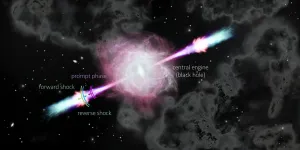(Press-News.org) Chatbots hold promise for dementia patient or caregiver support, but are still in their infancy, finds a paper published in the Journal of Medical Internet Research. None of the interactive digital apps tested by medical researchers and a computer scientist performed well on all testing criteria, and all the apps contained linguistic biases and usability challenges. The authors conclude that until developers produce evidence-based chatbots that have undergone end user evaluation it will be hard to evaluate their potential to adequately educate and support dementia patients and their caregivers.
"Dementia care is complex and no two cases of dementia are alike. Chatbots have the potential of providing caregivers with instant support that is evidence-based and personalized. While it was promising to find some advancements in this area, it was disappointing to learn that more hasn't been done," said first author Nicole Ruggiano, a professor of social work at the University of Alabama.
Chatbots have become a familiar presence in online customer service settings, and millions of people use personal digital assistants like Amazon's Alexa or Apple's Siri to perform tasks and retrieve information every day. Chatbots combine text or voice recognition, machine learning, and pre-programmed responses to afford users relatively seamless conversation with a human-like machine.
Healthcare chatbots can interpret symptoms, suggest resources, or offer emotional support.
"Artificial intelligence chatbots have great potential to improve the communication between patients and the healthcare system, given the shortage of healthcare staff and the complexity of the patient needs. This is especially important for dementia patients and caregivers, who keep increasing as the population ages, and face care challenges daily," said corresponding author Vagelis Hristidis, a professor of computer science in UC Riverside's Marlan and Rosemary Bourns College of Engineering, and founder of SmartBot360, a healthcare chatbot company.
Chatbots can provide memory training or stimulate fond recollections for dementia patients. Dementia patient caregivers, who often feel isolated and insufficient, can receive advice and emotional support from chatbots. The effectiveness of chatbot interventions, however, is only as good as the medical knowledge used in their programming and the quality of the user's interactions with the bot.
"In regards to the use of a chatbot by dementia caregivers, there are many content areas family caregivers may find helpful. Caregivers are confronted by increasing care coordination challenges, and a decline in function and overall well-being of the person living with dementia," said co-first author Ellen Brown, Erica Wertheim Zohar Endowed Chair in Community Mental Health at Florida International University. "Additionally, a new caregiver may look for very different resources and information than a more experienced caregiver."
To assess the potential for chatbots to assist with dementia care, a team of researchers from the University of Alabama, Florida International University, and UC Riverside identified 501 chatbot apps available for download on several popular platforms. After eliminating apps that had no chat feature, offered a chat with live humans, were not actually focused on dementia, were unavailable, or were a game, they ended up with 27 apps, only six of which fit all evaluation criteria. The apps that made the cut were: CogniCare mobile app; CogniCare (Alexa Skills version); My Life Story; Dementia Types; Build Your Brain Power; and Everything Memory.
The authors assessed the productivity, effectiveness, functionality and humanity, and overall satisfaction, including affect, ethics and behavior.
The apps were generally focused on the epidemiology and symptoms of dementia and less on caregiving skills and activities. It was difficult to start using all the apps, which would present a big hurdle for people without experience using computers or for people with dementia. The voice chatbot apps only responded to very specific pronunciations and vocabulary terms, limiting their use to certain speech styles and dialects. All six of the apps were only available in English, further limiting their usefulness.
However, once the researchers were able to get the programs started, they worked fairly well. Of the five chatbots designed to educate about dementia, three had a breadth of knowledge and flexibility in interpreting information. Users were able to interact with the apps in a human-like way, though only one, My Life Story, passed the Turing test, in which a person interacting with a computer cannot tell if it is a computer or real person. Some of the apps had features that increased the user's enjoyment, such as soft background music, and one app elicited interaction with comments such as, "Tell me more."
On ethics and privacy, only the two CogniCare apps, both produced by the same organization, fared well. All the other apps had various limitations that the researchers recommended should be improved to increase user confidence.
In general, the apps' limited program content made it hard to have extended or varied conversations between users and chatbots. Because dementia is complex and the symptoms varied, this could limit the education and support the apps provide. It also was not clear if information programmed into the apps came from evidence-based medical literature or professional practice, or more questionable Internet sources.
The authors conclude that although all the chatbots tested had attractive and useful features, none of them were likely to be effective providers of reliable, evidence-based information and advice or emotional support. Because chatbots have the potential to ease the burden for caregivers as well as to help dementia patients manage their own care, the authors recommend continued development and further research into chatbot apps for dementia.
INFORMATION:
The paper, "Chatbots to support people with dementia and their caregivers: systematic review of functions and quality," is available here. Co-authors include Lisa Roberts and Victoria Framil Suarez at Florida International University; and Yan Luo and Zhichao Hao at the University of Alabama.
Ozone is a pollutant at ground level, but very high in the atmosphere's "ozone layer," it absorbs damaging ultraviolet radiation. Past studies have examined ozone levels in the Southern Hemisphere, but little is known about levels of the molecule in Antarctica over long periods. Now, researchers reporting in ACS' Environmental Science & Technology have analyzed more than 25 years of Antarctic data, finding that concentrations near the ground arose from both natural and human-related sources.
Ozone gas has a sharp or acrid scent that sometimes accompanies smog or summer storms. It forms when sunlight ...
Microplastic pollution of waterways has become a huge concern, with the tiny pieces of plastic entering food webs and potentially having harmful effects on animals and people. In addition, microplastics can act as breeding grounds for antibiotic-resistant bacteria. Now, researchers reporting in Environmental Science & Technology have analyzed antibiotic-resistance genes (ARGs) on five types of microplastics at different locations along the Beilun River in China, finding much higher abundances in urban than rural regions.
In rivers, major sources of microplastics include textile fibers from laundering, water bottle fragments, and films from bags and wrappers. Also prevalent in ...
An international team of scientists, led by astrophysicists from the University of Bath in the UK, has measured the magnetic field in a far-off Gamma-Ray Burst, confirming for the first time a decades-long theoretical prediction - that the magnetic field in these blast waves becomes scrambled after the ejected material crashes into, and shocks, the surrounding medium.
Black holes are formed when massive stars (at least 40 times larger than our Sun) die in a catastrophic explosion that powers a blast wave. These extremely energetic events drive out material at velocities ...
Researchers using the Atacama Large Millimeter/submillimeter Array (ALMA) discovered a titanic galactic wind driven by a supermassive black hole 13.1 billion years ago. This is the earliest-yet-observed example of such a wind to date and is a telltale sign that huge black holes have a profound effect on the growth of galaxies from the very early history of the Universe.
At the center of many large galaxies hides a supermassive black hole that is millions to billions of times more massive than the Sun. Interestingly, the mass of the black hole is roughly proportional to the mass ...
The old cousins of the common woodlice were crawling on Irish land as long as 360 million years ago, according to new analysis of a fossil found in Kilkenny.
The research, published today (00.01 Wednesday 16 June) in the science journal Biology Letters, used state-of-the-art modern imaging technology to create a new picture of the Oxyuropoda - a land-based creature larger than the modern woodlice - using a fossil found in Kiltorcan, Co Kilkenny in 1908.
Lead researcher Dr Ninon Robin, a postdoctoral researcher at University College Cork's (UCC) School of Biological, Earth and Environmental Sciences said that their work advances science's understanding of when land-dwelling species of crustaceans roamed the earth, and what they looked like.
Dr Robin said:
"Woodlice, ...
Québec produces more strawberries than any other Canadian province. Strawberries are delicate and difficult to keep fresh. In response to this challenge, Monique Lacroix, a professor at at the Institut national de la recherche scientifique (INRS), and her team have developed a packaging film that can keep strawberries fresh for up to 12 days. The team's findings on how this film protects against mould and certain pathogenic bacteria have been published in Food Hydrocolloids.
The innovative film is made of chitosan, a natural molecule found in shellfish shells. This food industry by-product contains key antifungal properties ...
Thirty state-of-the-art IPCC-climate models predict dramatically different climates for the Northern Hemisphere, especially Europe. An analysis of the range of responses now reveals that the differences are mostly down to the individual model's simulations of changes to the North Atlantic ocean currents and not only - as normally assumed - atmospheric changes. The work, by Katinka Bellomo, National Research Council of Italy, Institute of Atmospheric Sciences and Climate, and colleagues is published today in Nature Communications and is part of the European ...
A study led by Fernando Colchero, University of Southern Denmark and Susan Alberts, Duke University, North Carolina, that included researchers from 42 institutions across 14 countries, provides new insights into the aging theory "the invariant rate of ageing hypothesis", which states that every species has a relatively fixed rate of aging.
- Human death is inevitable. No matter how many vitamins we take, how healthy our environment is or how much we exercise, we will eventually age and die, said Fernando Colchero.
He is an expert in applying statistics and mathematics to population biology and an associate professor at Department of Mathematics and Computer Science, University of Southern Denmark.
"We were able to shed light on the invariant rate of ageing hypothesis by combining ...
Teachers play a key role in supporting children's development in early childhood education classrooms such as Head Start. Research shows significant associations between teachers' depressive symptoms and their students' social and emotional development. However, little research has focused on the associations between teachers' depressive symptoms and academic outcomes of preschoolers from low-income families. Specifically, one important pathway that has not been examined is whether teacher depressive symptoms have implications for the quality of family-teacher relationships. This in turn could affect how supportive parents ...
An herbicide widely used in agriculture, forestry and other applications can cause deleterious effects on the reproductive health of a common perennial plant found in forests in British Columbia, Canada. Researchers reported in the journal END ...




